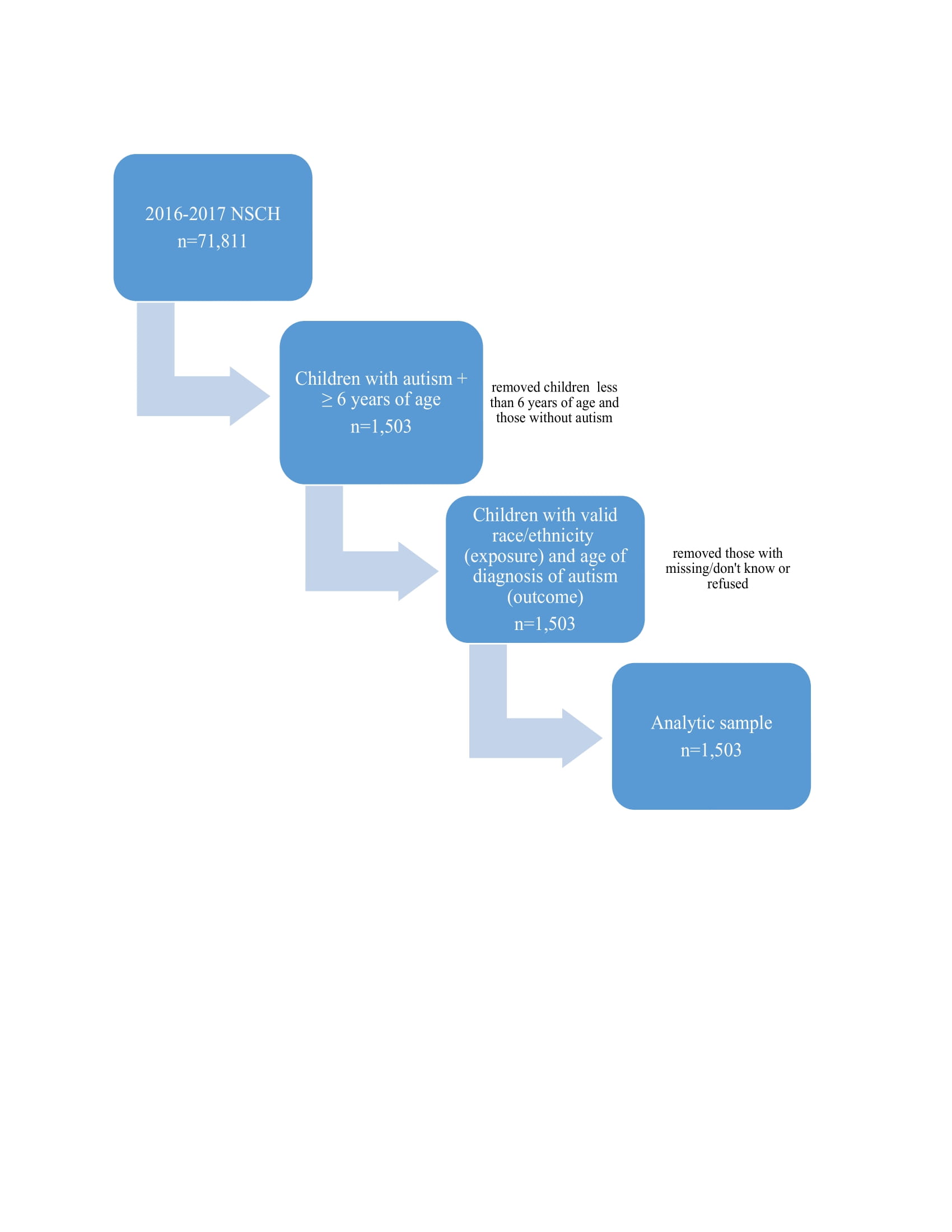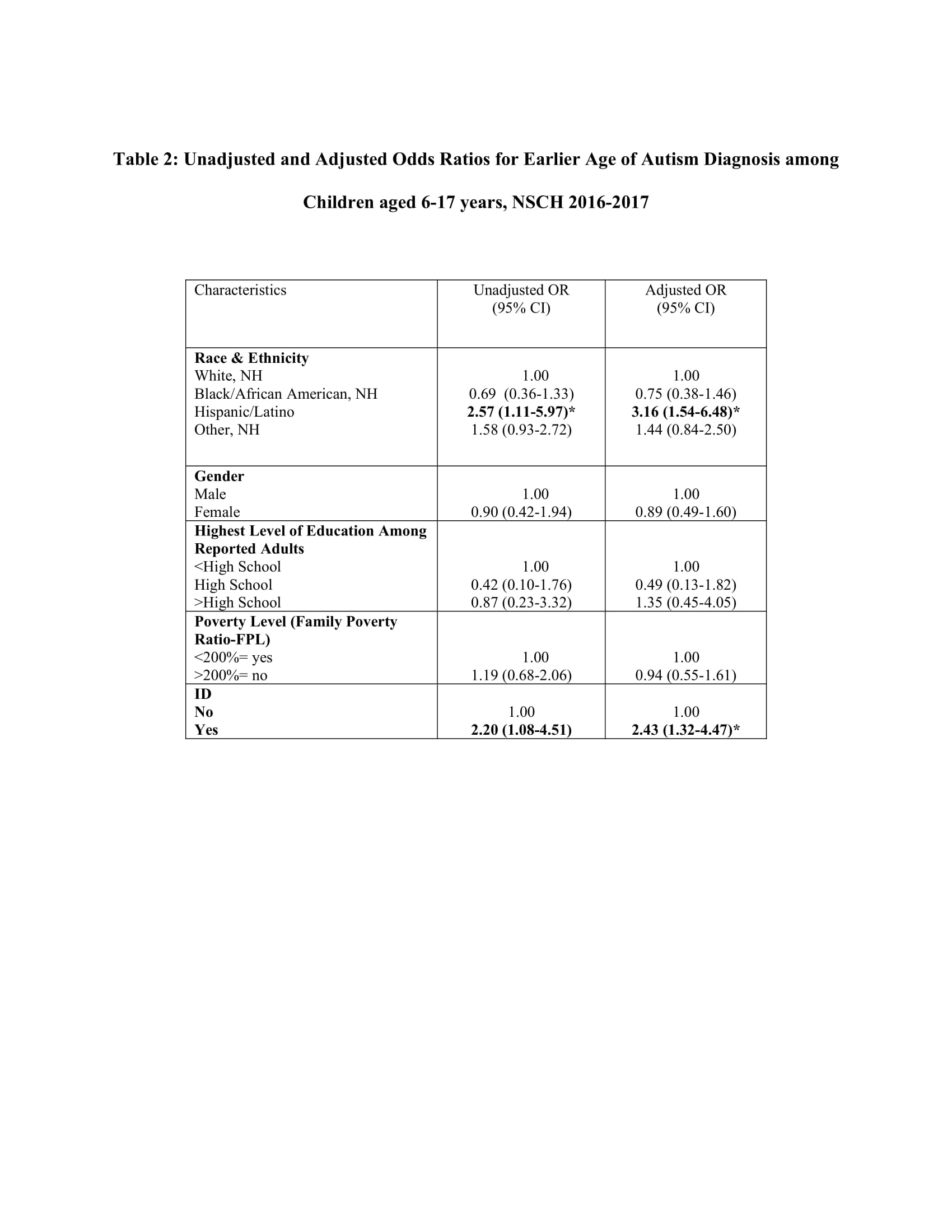Developmental and Behavioral Pediatrics: Autism
Category: Abstract Submission
Developmental and Behavioral Pediatrics: Equity
69 - The Association between Race and Ethnicity and Autism Diagnosis before Age 5 among Children 6-17 years old with ASD in the United States
Saturday, April 23, 2022
3:30 PM - 6:00 PM US MT
Poster Number: 69
Publication Number: 69.202
Publication Number: 69.202
Dalal Elsori, The Warren Alpert Medical School of Brown University, East Providence, RI, United States; Siraj Amanullah, The Warren Alpert Medical School of Brown University/Rhode Island Hospital/Brown School of Public Health, Warwick, RI, United States; Pamela C. High, The Warren Alpert Medical School of Brown University, Providence, RI, United States; yvette yatchmink, The Warren Alpert Medical School of Brown University, Providence, RI, United States; Annie Gjelsvik, Brown University, Providence, RI, United States
- DE
Dalal Elsori, MD
Fellow
The Warren Alpert Medical School of Brown University
East Providence, Rhode Island, United States
Presenting Author(s)
Background: Early diagnosis of autism spectrum disorders is essential in ensuring that children with ASD receive appropriate & timely services.
Racial and ethnic disparities in prevalence & age of diagnosis of ASD have been identified.
Objective: To examine the association between race and ethnicity and diagnosis of autism by age 5 in US children 6-17 with autism. In this nationwide population based study, white, non-Hispanic children are hypothesized be more likely to be diagnosed before the age of 5, compared to children of other races and ethnicities.
Design/Methods: Our study analyzed data from the National Survey of children’s health (NSCH) 2016-2017, administered to randomly selected subjects online and via mail in all 50 states and the District of Columbia. Our analytic sample contained 1,503 children diagnosed with autism and were greater than or equal to 6 years of age.
A binary variable was generated with two possible responses: “ < 5 years of age” and “≥ 5 years of age”. The primary exposures of interest in this study were race and ethnicity. We also looked at the influence of age, gender, highest level of education among reported adults and poverty level. Cross tabulations of exposure and outcome variables, as well as potential confounding variables, was performed using Stata/SE 15.0. Multivariable logistic regression analyses were then conducted to compare early age of diagnosis of autism and race and ethnicity, while adjusting for important demographic variables and confounders.
Results: 1503 children equal to or above the age of 6 with autism were analyzed according to their race and ethnicity. Of the 1503 children, 1070 (49%) were white, non-Hispanic (NH), 90 (13%) were black/African American (NH), 165 (32%) were Hispanic/Latino and 178 (7.4%) were of other races (NH).
Preliminary results indicate that among those children aged 6-17 who were white (NH), 45% were diagnosed with autism before the age of 5 compared to 36% black/African American (NH), 68% Hispanic/Latino and 56% of other races (NH).
On adjusting for gender, poverty level and highest level of education of reported adults, the OR for Hispanic/Latino children with autism aged 6-17 years in the US being diagnosed at an early age ( < 5 years of age) remained statistically significant at 3.16 (1.54-6.48) the odds of those children who were white (NH).Conclusion(s): Our results do not support our hypothesis and are not aligned with the most recent literature published on racial and ethnic disparities in 8 year olds with regards to age of autism diagnosis using a cutoff of 36 months, rather than 59 months of age, to designate early diagnosis.
Analytic Sample
Unadjusted and Adjusted Odds Ratios for Earlier age of Autism Diagnosis among Children Aged 6-17 years old
Racial and ethnic disparities in prevalence & age of diagnosis of ASD have been identified.
Objective: To examine the association between race and ethnicity and diagnosis of autism by age 5 in US children 6-17 with autism. In this nationwide population based study, white, non-Hispanic children are hypothesized be more likely to be diagnosed before the age of 5, compared to children of other races and ethnicities.
Design/Methods: Our study analyzed data from the National Survey of children’s health (NSCH) 2016-2017, administered to randomly selected subjects online and via mail in all 50 states and the District of Columbia. Our analytic sample contained 1,503 children diagnosed with autism and were greater than or equal to 6 years of age.
A binary variable was generated with two possible responses: “ < 5 years of age” and “≥ 5 years of age”. The primary exposures of interest in this study were race and ethnicity. We also looked at the influence of age, gender, highest level of education among reported adults and poverty level. Cross tabulations of exposure and outcome variables, as well as potential confounding variables, was performed using Stata/SE 15.0. Multivariable logistic regression analyses were then conducted to compare early age of diagnosis of autism and race and ethnicity, while adjusting for important demographic variables and confounders.
Results: 1503 children equal to or above the age of 6 with autism were analyzed according to their race and ethnicity. Of the 1503 children, 1070 (49%) were white, non-Hispanic (NH), 90 (13%) were black/African American (NH), 165 (32%) were Hispanic/Latino and 178 (7.4%) were of other races (NH).
Preliminary results indicate that among those children aged 6-17 who were white (NH), 45% were diagnosed with autism before the age of 5 compared to 36% black/African American (NH), 68% Hispanic/Latino and 56% of other races (NH).
On adjusting for gender, poverty level and highest level of education of reported adults, the OR for Hispanic/Latino children with autism aged 6-17 years in the US being diagnosed at an early age ( < 5 years of age) remained statistically significant at 3.16 (1.54-6.48) the odds of those children who were white (NH).Conclusion(s): Our results do not support our hypothesis and are not aligned with the most recent literature published on racial and ethnic disparities in 8 year olds with regards to age of autism diagnosis using a cutoff of 36 months, rather than 59 months of age, to designate early diagnosis.
Analytic Sample

Unadjusted and Adjusted Odds Ratios for Earlier age of Autism Diagnosis among Children Aged 6-17 years old

